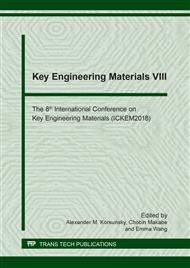[1]
Shi, K., K. Spindler, and E. Hahne, Heat transfer in nucleate boiling of R134a/R152a mixtures. Heat and Mass Transfer, 2010. 46(10): pp.1137-1145.
DOI: 10.1007/s00231-010-0688-1
Google Scholar
[2]
Dong, X.-Q., et al., Prediction of homogeneous azeotropes by Wilson equation for binary HFCs and HCs refrigerant mixtures. Fluid Phase Equilibria, 2008. 269(1-2): pp.6-11.
DOI: 10.1016/j.fluid.2008.04.012
Google Scholar
[3]
Azzolin, M., S. Bortolin, and D. Del Col, Predicting Methods for Flow Boiling Heat Transfer of a Non-Azeotropic Mixture Inside a Single Microchannel. Heat Transfer Engineering, 2016. 37(13-14): pp.1136-1147.
DOI: 10.1080/01457632.2015.1111114
Google Scholar
[4]
Demenezes, E., et al., Addition of an azeotropic ETBE/ethanol mixture in eurosuper-type gasolines. Fuel, 2006. 85(17-18): pp.2567-2577.
DOI: 10.1016/j.fuel.2006.04.014
Google Scholar
[5]
Ding, Y., et al., The effect of azeotropic blended fuel on combustion characteristics in a ceiling vented compartment. Fuel, 2017. 189: pp.1-7.
DOI: 10.1016/j.fuel.2016.10.095
Google Scholar
[6]
Li, D., et al., Effects of dimethyl or diethyl carbonate as an additive on volatility and flash point of an aviation fuel. J Hazard Mater, 2009. 161(2-3): pp.1193-201.
DOI: 10.1016/j.jhazmat.2008.04.070
Google Scholar
[7]
Ding, Y., C. Wang, and S. Lu, The effect of azeotropism on combustion characteristics of blended fuel pool fire. J Hazard Mater, 2014. 271: pp.82-8.
DOI: 10.1016/j.jhazmat.2014.02.012
Google Scholar
[8]
Modak, A.T., Thermal radiation from pool fires. Combustion and Flame, 1977. 29(Supplement C): pp.177-192.
DOI: 10.1016/0010-2180(77)90106-7
Google Scholar
[9]
Zhou, L., et al., Total radiative heat loss and radiation distribution of liquid pool fire flames. Fire Safety Journal, 2017. 89: pp.16-21.
DOI: 10.1016/j.firesaf.2017.02.004
Google Scholar
[10]
Deng, H., M. Fernandino, and C.A. Dorao, A numerical investigation of flow boiling of non-azeotropic and near-azeotropic binary mixtures. International Journal of Refrigeration, 2015. 49: pp.99-109.
DOI: 10.1016/j.ijrefrig.2014.10.003
Google Scholar


